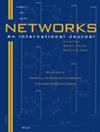Mean‐standard deviation model for minimum cost flow problem
IF 1.3
4区 计算机科学
Q4 COMPUTER SCIENCE, HARDWARE & ARCHITECTURE
引用次数: 0
Abstract
We study the mean‐standard deviation minimum cost flow (MSDMCF) problem, where the objective is minimizing a linear combination of the mean and standard deviation of flow costs. Due to the nonlinearity and nonseparability of the objective, the problem is not amenable to the standard algorithms developed for network flow problems. We prove that the solution for the MSDMCF problem coincides with the solution for a particular mean‐variance minimum cost flow (MVMCF) problem. Leveraging this result, we propose bisection (BSC), Newton–Raphson (NR), and a hybrid (NR‐BSC)—method seeking to find the specific MVMCF problem whose optimal solution coincides with the optimal solution for the given MSDMCF problem. We further show that this approach can be extended to solve more generalized nonseparable parametric minimum cost flow problems under certain conditions. Computational experiments show that the NR algorithm is about twice as fast as the CPLEX solver on benchmark networks generated with NETGEN.最小成本流问题的均值-标准差模型
我们研究了平均-标准偏差最小成本流(MSDMCF)问题,其中目标是最小化流量成本的平均和标准偏差的线性组合。由于目标的非线性和不可分割性,该问题不适用于为网络流问题开发的标准算法。我们证明了MSDMCF问题的解与特定均值-方差最小成本流(MVMCF)问题的解一致。利用这一结果,我们提出了平分(BSC)、Newton–Raphson(NR)和混合(NR‐BSC)方法,试图找到特定的MVMCF问题,其最优解与给定MSDMCF问题的最优解一致。我们进一步证明,在一定条件下,这种方法可以推广到求解更广义的不可分离参数最小成本流问题。计算实验表明,在使用NETGEN生成的基准网络上,NR算法的速度大约是CPLEX求解器的两倍。
本文章由计算机程序翻译,如有差异,请以英文原文为准。
求助全文
约1分钟内获得全文
求助全文
来源期刊

Networks
工程技术-计算机:硬件
CiteScore
4.40
自引率
9.50%
发文量
46
审稿时长
12 months
期刊介绍:
Network problems are pervasive in our modern technological society, as witnessed by our reliance on physical networks that provide power, communication, and transportation. As well, a number of processes can be modeled using logical networks, as in the scheduling of interdependent tasks, the dating of archaeological artifacts, or the compilation of subroutines comprising a large computer program. Networks provide a common framework for posing and studying problems that often have wider applicability than their originating context.
The goal of this journal is to provide a central forum for the distribution of timely information about network problems, their design and mathematical analysis, as well as efficient algorithms for carrying out optimization on networks. The nonstandard modeling of diverse processes using networks and network concepts is also of interest. Consequently, the disciplines that are useful in studying networks are varied, including applied mathematics, operations research, computer science, discrete mathematics, and economics.
Networks publishes material on the analytic modeling of problems using networks, the mathematical analysis of network problems, the design of computationally efficient network algorithms, and innovative case studies of successful network applications. We do not typically publish works that fall in the realm of pure graph theory (without significant algorithmic and modeling contributions) or papers that deal with engineering aspects of network design. Since the audience for this journal is then necessarily broad, articles that impact multiple application areas or that creatively use new or existing methodologies are especially appropriate. We seek to publish original, well-written research papers that make a substantive contribution to the knowledge base. In addition, tutorial and survey articles are welcomed. All manuscripts are carefully refereed.
 求助内容:
求助内容: 应助结果提醒方式:
应助结果提醒方式:


